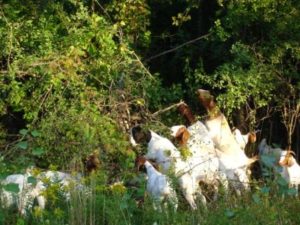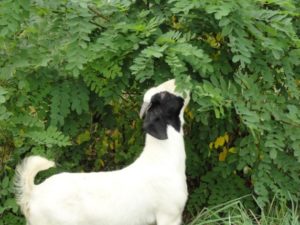Using Goats for Vegetation Management in the Northeast
The climate of the Northeast is favorable for growing lush vegetation, but sometimes too many of the wrong plants grow in the wrong place. Ignoring the situation will often lead to greater costs and problems further down the road. Goats are an increasingly popular option for managing vegetation in other regions of the United States, but to date have not been widely used in the Northeast for this purpose. However, the strong demand for goat meat, the increased demand for organic control methods, and the cumulative experiences of managing goats in the northeast are just a few factors that suggest new opportunities for this application.
Goats are intelligent, docile animals with a knack for eating weeds, brush and just about anything with a green leaf. They can be used in places that are inoperable with equipment or off-limits to herbicides, while at the same time generate income and other benefits. Nonetheless, achieving the desired results with goats requires skilled management and a well-designed system. Although there is no one right way to utilize goats on the landscape for targeted control of unwanted plants, the following highlights some of the most important considerations for success.
Develop a Plan
Goats can be a viable alternative to other control methods, but good planning is essential for good results. The first step is to identify the objectives and determine if goats will be able to accomplish them. If so, are goats the most practical option?
Who will care for the goats and how much of an investment is needed both to get started and operate over time? What is a reasonable level of vegetation control and how will you adapt the project if targets are not being met? Will the goats be used for temporary clearing, or for long-term maintenance and management? Where will you find the goats, and how will you keep them healthy and dispose of excess animals? Is the plan flexible enough to adapt over time as vegetation and other conditions change? These are just a few of the points to address in a written plan prior to implementation.
Know the Foe
Different plants respond in different ways to browsing and defoliation. Vegetation can be categorized into one of four groups: grass-like plants (monocots); broad-leaf herbaceous plants (“weeds”); woody shrub-like plants (“brush”); and, trees. Each group, and even species within a group, has a different tolerance level for disturbance and defoliation, as well as a different ability to recover, persist and reproduce. Every plant also has a different level of attractiveness to goats, which tend to preferentially browse the “tastiest” plants first. Some plants may be very unpalatable, or even toxic to goats. Generally speaking, there is a decreased tolerance to browsing moving from grass-like plants to trees, and also decreased accessibility to the edible portions of the plant. In other words, goats can usually reach more of the edible potions of herbaceous plants – but these same plants are usually more resilient to the browsing action of goats. Two other points to consider are, what will take the place of the vegetation that is being controlled, and how might excessive damage to desirable plants be mitigated?
Winning the Battle

Goats will normally lightly browse plants, gleaning the most palatable portions before moving on to other plants. Photo by Brett Chedzoy
Undesirable vegetation can be controlled with goats through a combination of impacts, which include: repeated defoliation which weakens or kills targeted plants; girdling; trampling; and, increased ground light levels (through defoliation of over-topping vegetation) which encourages the establishment of more desirable and stable plant communities. In some cases, it may be practical to add additional livestock, such as cattle or pigs, to trample and root-up more difficult plants. Initial mechanical treatments may also be needed to make targeted plants more accessible. One example of this combination is mowing to reduce vegetation to a more manageable level, followed by goats to control re-growth and sprouting.
Workforce Management
A band of goats will literally work for food, but they need special forms of instruction and encouragement to perform their jobs well. One key to effective vegetation management with any livestock is the ability to reliably keep the animals in the desired location for the desired period of time. Vegetation management usually requires extensive and repeated impact to the targeted plants, which is contrary to goat behavior. Goats will normally lightly browse plants, gleaning the most palatable portions before moving on to other plants. But to significantly weaken or kill these plants, goats must be forced to defoliate and damage the plants more extensively. This requires secure fencing and an experienced eye to know how much the goats can tolerate. Water, shelter and supplements such as salt – or even the tethering of a lead animal or guard animal that the group is bonded to – are possible tactics for guiding and limiting the movement of goats. But some kind of fencing will probably be necessary as well to concentrate their activities. Although panels and woven wire may work in some situations, a well-electrified fence is probably the most effective – and cost-effective over time. Portable and temporary options like polytwine and electro-net work well if adequately charged and if cleared paths exist for installation. Electrified high-tensile wire, or the combination of woven with high-tensile wire are the best options when goats will be used on the same area over a period of years. Secure fences can also help to crowd animals enough to create competition for food and enhance aggressive browsing behavior. A good fence also protects goats from predator threats and increases their sense of security, which makes them easier to contain.
Learning More
The use of goats to control vegetation requires solid knowledge of both goats and plants. Developing the skill to effectively use this knowledge requires experience. Starting out small will soften the learning curve and allow the flexibility to experiment. Some resources for learning more about goats and their management in wooded environments are:
- Cornell goat program
- “Goats in the Woods”, “Guide to Silvopasturing in the Northeast”
- NY invasive species clearinghouse



Hello Teacher ,I have my question help me please,tell me the name of the plant feeding grown most in Coral area and palatable for feeding by goats